
The Sundorph House is a Neoclassical property at Ved Stranden 10 in the Old Town of Copenhagen, Denmark. The property has since the late 17th century been owned by members of the Sundorph family. The current building was constructed for tea merchant Mette Christine Sundorph after the previous building at the site was destroyed in the Copenhagen Fire of 1795. It was listed in the Danish registry of protected buildings and places in 1918.
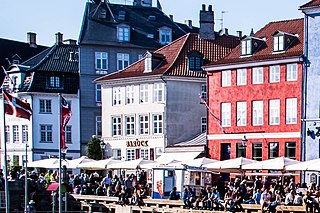
Nyhavn 1 is an 18th-century property at the acute corner of Nyhavn with Store Strandstræde in central Copenhagen, Denmark. It was listed in the Danish registry of protected buildings and places in 1987. Notable former residents include actor and singer Peter Schram (1819–1895).

Studiestræde 21 is a Neoclassical property in the Latin Quarter of Copenhagen, Denmark. The building was listed on the Danish registry of protected buildings and places in 1951,

Gammel Strand 40 is a Neoclassical property overlooking Slotsholmen Canal in the Olt Town of Copenhagen, Denmark. The building was listed in the Danish registry of protected buildings and places in 1945. A commemorative plaque above the doorway commemorates that Georg Carstensen, founder of Tivoli Gardens, was a resident in the building when his amusement park opened in 1843. Other notable former residents of Gammel Strand 40 include the archeologist Peter Oluf Brøndsted, writer and editor Jacob Davidsen (1813–1891), songwriter Peter Faber, politician and bishop Ditlev Gothard Monra and journalist Henrik Cacling.d

Lille Strandstræde 12 is an 18th-century property situated in the Nyhavn Quarter of central Copenhagen, Denmark. The building owes its current appearance to an adaptation in 1858. It was listed in the Danish registry of protected buildings and places in 1950. Notable former residents include the politician Peter Sabroe.

Brolæggerstræde 4 is a Neoclassical property situated in the Old Town of Copenhagen, Denmark. Like most of the other buildings in the area, it was constructed as part of the rebuilding of the city following the Copenhagen Fire of 1795. The three-winged complex was listed in the Danish registry of protected buildings and places in 1950.
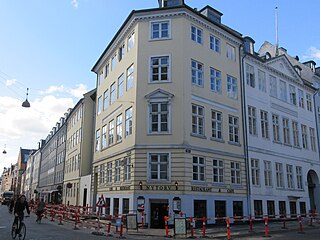
Nytorv 15/Rådhusstræde 2 is a Neoclassical property situated at the corner of Nytorv and Rådhusstræde in the Old Town of Copenhagen, Denmark. It consists of two separate buildings, the corner building from 1797 and an eight-bay building from 1798, now connected by a narrow modern infill. The building was listed in the Danish registry of protected buildings and places in 1945. Notable former residents include jurist, writer and publisher Jacob Just Gudenrath (1657–1825), actors Stephan and Eline Heger, theatrical painter Edvard Lehmann and portrait painter hristian Frederik Christensen (1805-1883).

Dronningens Tværgade 5 is a Neoclassical property situated in Dronningens Tværgade, opposite the Moltke Mansion, in central Copenhagen, Denmark. The building fronting the street, together with the adjacent buildings at No. 7 and No. 9, was constructed in 1793–1794 by master builders Hans Ondrup and A. Giedde. At the rear, there is a three-storey side wing and a one-storey former bank building, both dating from c. 1850. The entire complex was listed in the Danish registry of protected buildings and places in 1951 and 1999. Notable former residents include the jurist and later prime minister of Denmark Peter Georg Bang, the military officer Hans Dahlerup and the poet and author Vita Andersen.

Naboløs 1 is a Neoclassical property situated at the corner of the streets Neboløs and Læderstrlde, close to Gammel Strand, in the Old Town of Copenhagen, Denmark. Together with the adjacent buildings at Naboløs 3 and Gammel Strand 52, it was constructed by Hans Christian Ondrup as part of the rebuilding of the city following the Copenhagen Fire of 1795. It was listed in the Danish registry of protected buildings and places in 1945.

Knabrostræde 19 is a Neoclassical property situated at the corner of Knabrostræde and Kompagnistræde in the Old Town of Copenhagen, Denmark. It was constructed by Johan Martin Quist as part of the rebuilding of the city following the Copenhagen Fire of 1795. The building was listed in the Danish registry of protected buildings and places in 1918. Comedy Zoo, Copenhagen's leading comedy club, is based in the building. Notable former residents include the musician and composer Ivar Bredal and the architectural painter Niels Bredal.

Rådhusstræde 10 is a complex of 18th and 19th-century buildings situated at the corner of Rådhusstræde and Vandkunsten in the Old Town of Copenhagen, Denmark. It consists of a two-storey corner building from 1750, a three-storey building in Rådhusstræde from 1851 and a rear wing from 1835. The entire complex was listed in the Danish registry of protected buildings and places in 1945.
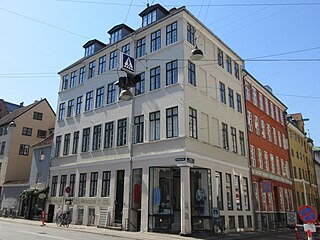
Rådhusstræde 8 is an 18th-century property situated at the southern corner of Rådhusstræde and Kompagnistræde in the Old Town of Copenhagen, Denmark. It was listed in the Danish registry of protected buildings and places in 1945. Notable former residents include the historians Frederik Sneedorff (1760–1792) and Laurids Engelstoft, later Minister of Interior Affairs I.J. Unsgaard (1798–1872), writer Niels Christian Øst (1779–1842), instructor and former solo dancer at the Royal Danish Theatre Carl Dahlén and architect Martin Nyrop.

The Journalists' House, situated at Gammel Strand 46, opposite Thorvaldsens Museum and Christiansborg Chapel, is the Danish Union of Journalists' headquarters in Copenhagen, Denmark. The Neoclassical building was constructed by Andreas Hallander as part of the rebuilding of the city following the Copenhagen Fire of 1795, incorporating elements from the previous building on the site. It was listed in the Danish registry of protected buildings and places in 1918. Notable former residents include the clergy Christian Bastholm, poet and translator Ditlevine Feddersen, agriculturalist Oluf Christian Olufsen, naval officers Peter Norden Sølling and Carl Irminger, opera director and choir conductor Giuseppe Siboni, court physician Joachim Lund Drejer, ballet master August Bournonville, schoolmistress Natalie Zahle and church historian Carl Joakim Brandt.

Kompagnistræde 24 is a Neoclassical property situated on Strædet, between Knabrostræde and R¨dhusstræde, in the Old Town of Copenhagen, Denmark. It was constructed as part of the rebuilding of the city following the Copenhagen Fire of 1795 and later heightened with one storey in 1849. The building was listed in the Danish registry of protected buildings and places in 1979. Notable former residents include the artist Janus Laurentius Ridter.

The Gyldendal House, situated at Klareboderne 3, is the current headquarters of the Gyldendal publishing house in Copenhagen, Denmark. The 15-bays-long Baroque style town mansion was constructed by master mason and stucco artist Abraham Stoy in the 1740s. It was acquired by Gyldendal-founder Søren Gyldendal in 1787, and his publishing house has been headquartered in the building since then. A large new rear wing was constructed in the 1870s. The front wing was listed in the Danish registry of protected buildings and places in 1918.
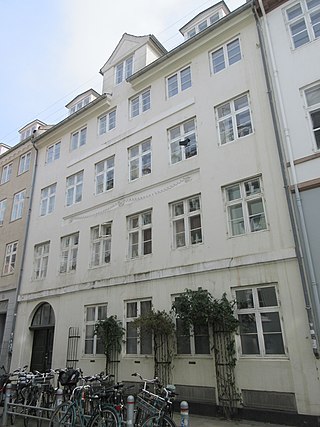
Brolæggerstræde 3 is a Neoclassical buildings situated in the Old Town of Copenhagen, Denmark. It was like most of the other buildings in the street constructed as part of the rebuilding of the city following the Copenhagen Fire of 1795. A distillery was for the first many years operated in the courtyard. The property was listed in the Danish registry of protected buildings and places in 1945.

Kompagnistræde 20 is a Neoclassical building complex situated at the corner of Kompagnistræde and Knabrostræde in the Old Town of Copenhagen, Denmark, constructed in 1796–97 as part of the rebuilding of the city following the Copenhagen Fire of 1795. A brewery was for more than 200 years, from at least the late 1640s until the 1860s, operated on the site. The building complex comprises a residential corner building as well as an adjacent warehouse at Knabrostræde 16 and another warehouse in the courtyard. The entire complex was listed in the Danish registry of protected buildings and places in 1945. Notable former residents include the government official Jacob Gude, civil servant and later Minister of Interior Affairs I.J. Unsgaard and painter and photographer Edvard Valdemar Harboe.

Admiralgade 28 is a Neoclassical building situated at the corner of Admiralgade and Boldhusgade in the Old Town of Copenhagen, Denmark. Constructed in 1798–99 by the prolific master builders Philip Lange and Lauritz Laurberg Thrane as part of the rebuilding of the city following the Copenhagen Fire of 1795., it is now part of a large complex of ministerial buildings which comprises the entire block. The building was listed in the Danish registry of protected buildings and places in 1950. Copenhagen's Student Association (Studenterforeningen) was based in the building from 1824 to 1831 and again from 1742 to 1863. Other notable former residents include the music retailers and publishers CCarl Christian Lose den ældre, merchant and Cherry Heering-manufacturer Peter Heering and the graphical studio Pacht & Crone.

Skindergade 22 is a Neoclassical building situated at the corner of Skindergade and Lille Kannikestræde in the Old Town of Copenhagen, Denmark. It was listed in the Danish registry of protected buildings and places in 1979. Jens Andersen Hansen, publisher of the newspaper Almuevennen and a member of the Danish Constituent Assembly, was a resident of the building in around 1849.
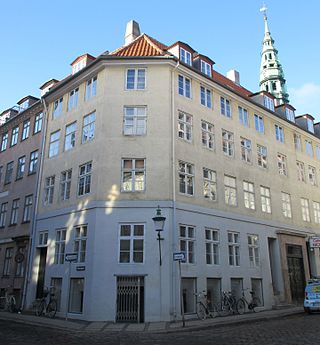
Nikolajgade 20 / Dybensgade 20 is a Neoclassical apartment building situated at the corner of Nikolajgade and Dybensgade in central Copenhagen, Denmark. The building was constructed by master mason Anthon Christian Wilcken and master carpenter Andreas Hallander in 1799–1800 as part of the rebuilding of the city following the Copenhagen Fire of 1795. It was listed on the Danish registry of protected buildings and places in 1959. A young Hans Christian Andersen was the lodger of a widow on the second floor in the early 1820s. From 1825 to 1840 the building was operated as a home for indigent seamen under the name Bombebøssen. That institution—founded by the naval officer Peter Norden Sølling in 1819— was then moved to Christianshavn. The building at the corner of Nikolajgade and Dybensgade was hit by fire in 1855 but subsequently restored.






















